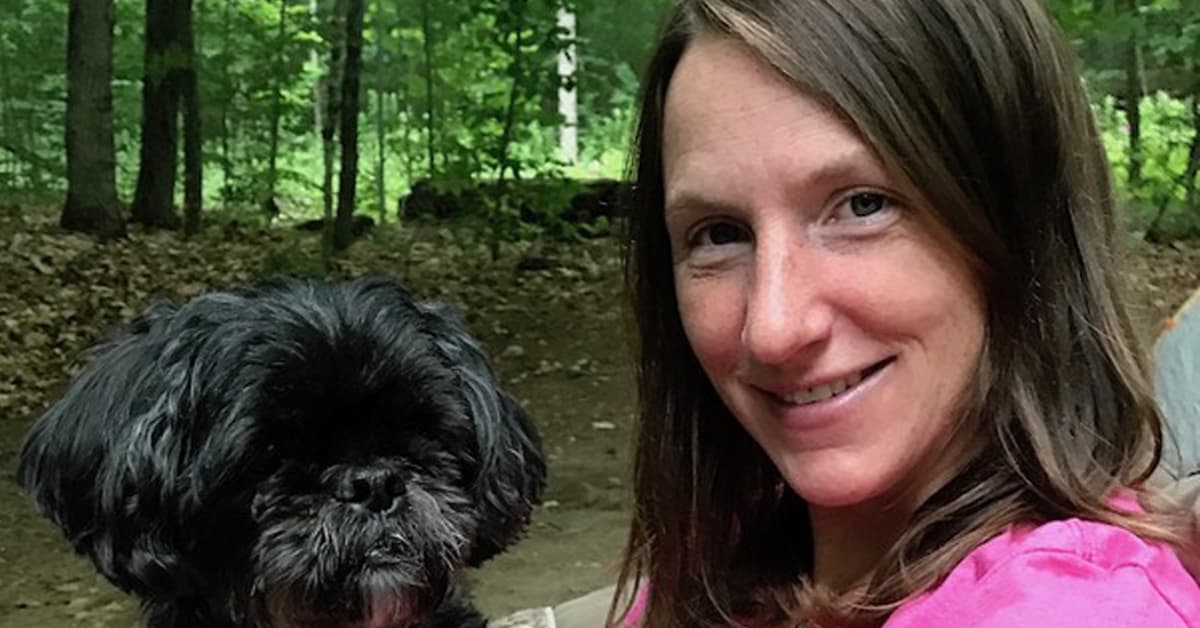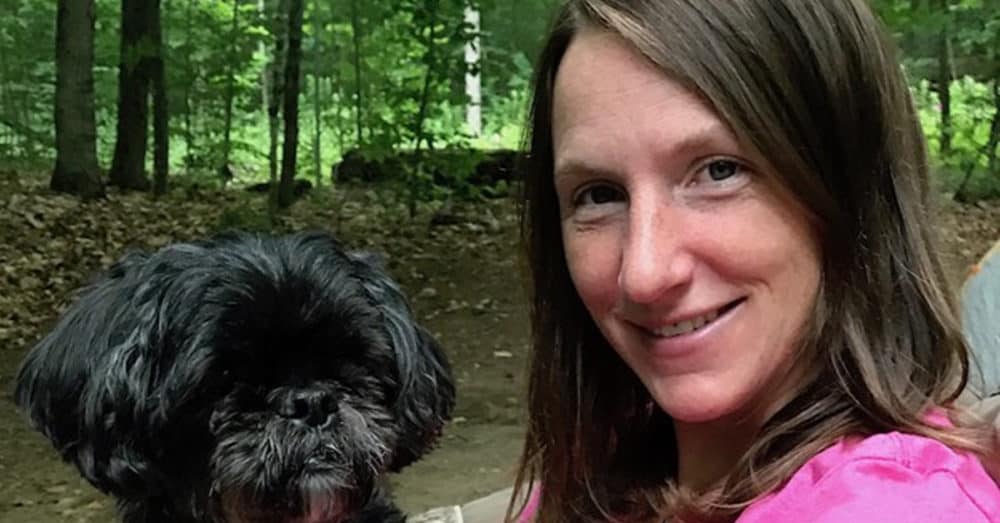November 2018 KPA CTP of the Month
Heather Adams, KPA CTP, first discovered Karen Pryor Academy (KPA) through an internet search as she sought help for Sadie, her dog with severe separation anxiety. Now a KPA CTP and the owner of the dog-training business Clever Paws, Heather helps other dogs with behavior issues, often introducing them to the worlds of obedience and agility.

Karen Pryor’s books Don’t Shoot the Dog and Getting Started: Clicker Training for Dogs had already helped Heather before she launched her internet search. “The things I learned made such a difference for Sadie, but I wanted to learn more,” says Heather. “I was ecstatic to find the online course.”
Heather and her golden retriever, Tucker, completed the KPA Dog Trainer Professional (DTP) program in October 2008, beginning the course when they lived in Las Vegas and finishing it after a move to Alaska. “We flew down to Seattle to work with Terry Ryan for our last two workshops. We even got in a one-day chicken camp,” reports Heather. She thought Terry's workshops were wonderful and “her continued mentorship after the course was so helpful.” Heather marks her 10-year anniversary as a KPA CTP this month, saying “I've always wanted to run my own business, something that would involve animals, and the KPA approach seemed like the perfect fit!”
The first DTP workshop was an eye-opening and positive experience for Heather. “It left me on cloud 9.” Her strong memory is that “no one told me what I did wrong. They just praised and encouraged me.” A former science teacher, Heather brings natural skills to dog training, along with an appreciation and concern for how students learn. When she and Tucker were beginning to learn together, Heather felt some uncertainty. She remembers, “Before the first workshop I wasn't sure Tucker was getting it or that I was using the clicker right.” They discovered that not only was Tucker “getting” clicker training, he was having fun (as was Heather!). “The idea that dogs would experience fun being trained with positive reinforcement made me so happy,” Heather says. “I remember that feeling when I'm teaching my own students. I want them to feel the same way and their dogs to enjoy training with me that much, too.”
Heather’s business developed bit by bit after she finished the KPA program. “I started offering just private lessons since I had no training space of my own.” Meeting the instructor of a local animal-training class, someone who owned her own business, led to an opportunity for Heather. “The instructor found out that I was a KPA graduate and offered me a job on the spot, without knowing anything else about me.” The KPA reputation launched Heather’s experience teaching classes. “It was a great opportunity to teach and learn in a group setting,” she says.

The instructor found out that I was a KPA graduate and offered me a job on the spot...

Clicker training skills, and learning how to teach those skills to others, have helped Heather with a specific population. “Clicker training has been incredibly helpful teaching disabled and elderly people who aren't capable of moving a dog around physically, luring with treats, or using traditional methods that require strength or intimidation. I love watching their faces light up as they train their dogs from their couch or wheelchair.”
Setting up a dog for success was an important KPA takeaway for Heather, in agility and in everyday training of foundation skills. “The 101 Things to Do with a Box exercise is a great way to introduce dogs and people to clicker training,” says Heather. “It is still something I use in every foundation class.”
Heather loves to train human/canine pairs in obedience and agility “for fun or for competition.” When she was first involved in agility, participating with her own dogs, “Everyone was teaching by simply luring the dogs over the obstacles with treats. It was ineffective, and we struggled!” she recalls. KPA gave Heather the belief and the skills to “clicker train dogs to do just about anything they are physically capable of doing.” She started to shape her dogs' behavior with each obstacle, “essentially retraining everything.” The results were worth the effort, though. “We went from struggling to qualifying at trials!”
Heather has found that clicker training is the key to agility team’s success. “The goal is for each part of the team to know its job. The handler's job is to direct the dog to each obstacle on the course, and the dog's job is to follow that handling and know how to do that obstacle without additional help from the handler.” Since “agility is all about independent obstacle performance, the best way to learn those behaviors is to use clicker training and shaping,” according to Heather. Dogs learn how to perform each obstacle behavior without requiring a handler to be right next to them. Heather laughs, “This is really helpful when you've got a fast dog!”
In getting to agility success, the principle of “behavior first, reward follows” brings incredible accomplishment compared to luring with treats. With the former, “the dog figures out how to move away from their person, do a behavior, and have it pay off. Dogs come get their treats and run right back to do the obstacle again—all of their own free will,” explains Heather.
Heather reports that it is challenging when her human agility students “want to get the dog doing it right away and wonder why we're doing all these weird exercises with the clicker!” But when they start putting together the pieces, it makes more sense. “Most people are grateful they took the time to learn foundation skills. Foundation training is fun, but it's not as sexy as running over the real agility equipment!”
Her students’ stories also reinforce the value of clicker training to Heather. One student’s dog was slow on an agility course and seemed afraid of a piece of equipment, the teeter. Heather reports that clicker training allowed that dog to learn that even just approaching and sniffing the teeter paid off. That payoff led the dog to continue: sniff it, touch it with her nose, put a tentative paw on it. “No one cheered her on or tried to lure or convince her it was safe. She was allowed to approach the equipment when she chose to, and those choices led to great results! The power of free choice beats fear every time, and the clicker helps make it clear which specific choices pay off.”
Heather refers again to Don't Shoot the Dog in summing up how clicker training can be applied to all areas of life. “When I get phone calls from frustrated or outright angry people [in my job outside of dog training], I've found that just listening as they vent and responding with kindness and understanding stops them in their tracks almost every time. Usually they end up apologizing and we get on to solving the issue.”
At home, Heather’s husband has caught on. “It's pretty funny when I give him a hug or kiss and thank him for washing the dishes or vacuuming. He says, ‘I know what you're doing, and you can't train me!’” Like many others, Heather has found that “in any relationship listening and understanding where a person is coming from is like rewarding a behavior. It does more to open the line of communications than any effort to convince or force a person.”
Heather continues to learn by participating in seminars and workshops each year. While in the past, her training focus was on solving behavior issues, Heather is making a change. “I plan to transition to only agility training, and my continuing education is becoming more focused on that, too. I finally have my own training facility, which is key to teaching agility,” she reports.
Looking ahead, Heather hopes to compete in agility on a national level with her young dog, using clicker training, of course. “Students want to learn from someone they view as successful.” Her new goal of transitioning her business to agility primarily will include clicker training offerings at all levels of classes and private lessons. “I also plan to get sheep for my border collies. I think it will be fun to teach them a few tricks! Maybe even some agility!”

